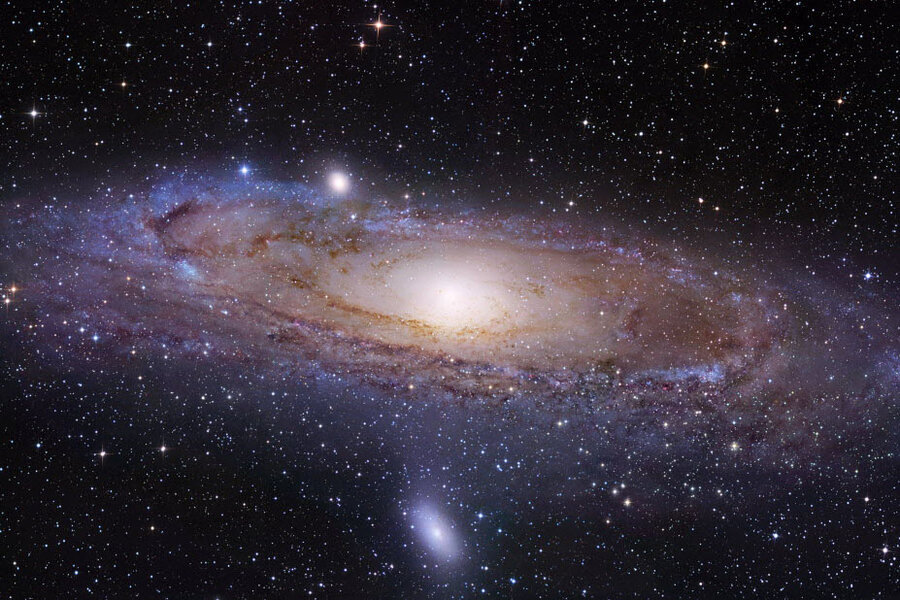Can Andromeda's vast halo of gas help explain how galaxies form?
On a clear night, with binoculars and a sky free of light pollution, you can readily pick out a faint, fuzzy patch of light – the star-packed central bulge of the Milky Way's neighbor, the Andromeda galaxy.
For Nicolas Lehner and colleagues, however, it's what you can't see that constitutes the main show – a tenuous halo of gas surrounding Andromeda. That gas could reveal important clues about the formation and evolution of large spiral galaxies such as Andromeda and the Milky Way.
Using data from the Hubble Space Telescope, the team has found that Andromeda's halo is some 2 million light-years across, some six times larger than previously measured.
The halo's gas, the raw material for new stars, contains enough mass to equal half of the mass of all the stars in the galaxy. Through cosmic time, this gas has helped sustain a robust rate of star birth in the galaxy, 2.5 million light-years away.
Yet Andromeda appears to be shutting down star formation, despite the new-found abundance of gas in the halo. What cuts off the return of this raw material to the galaxy?
"That is the $1-million question," one Andromeda and its heft halo would help answer, says Dr. Lehner, an astronomer at the University of Notre Dame in Indiana. Lehner is the lead author of a paper describing the results. It is set for publication in the May 10 issue of The Astrophysical Journal.
The team produced the most extensive map yet of Andromeda's halo by combing through the Hubble Space Telescope archives. It took its cue from a project known by its shorthand name – COS-Halo.
That project, led by Jason Tumlinson, an astronomer at the Space Telescope Science Institute in Baltimore, analyzed gas halos surrounding 44 galaxies that were much farther away than Andromeda, but in Andromeda's general direction.
Using Hubble's Cosmic Origins Spectrometer, which hunts for the fingerprints of chemical elements at ultraviolet wavelengths, and the most powerful "lamps" in the cosmos – distant, active galaxies known as quasars, Dr. Tumlinson's team gleaned some information about the tenuous halos around theses 44 galaxies. But mapping the extent of the halos wasn't possible. The galaxies were so far away and the apparent sizes of their halos were so small that each halo was backlit by only one quasar.
Andromeda, by contrast, is close enough for its halo to intercept the light from many quasars. For this study, the team found 18 quasars backlighting Andromeda's halo at distances ranging from roughly 121,000 light-years from the galaxy's center to as far as 1.5 million light-years out. At each point, the team used the ultraviolet spectral signatures of silicon to identify the gas and map the halo's extent.
The researchers were able to get an initial, crude estimate of changes in the gas's mass with distance from the galaxy. And they were able to determining that the gas is gravitationally bound to Andromeda; it's not fleeing to greener galaxies.
Based on modeling studies, the gas halo formed at the same time Andromeda did some 9 billion years ago. The presence of silicon, as well as carbon and oxygen in the halo, which form in fusion reactions at the hearts of stars, speak to billions of years of enrichment as the most massive of these stars exploded and hurled these elements into the halo.
The relationship between the halo and star formation and the means for regulating the star-formation process remain open issues, Lehner says.
For galaxies at the height of star formation, gravity draws gas from the halo in to serve as the raw material for new stars. The picture is far different for spiral galaxies that have evolved into large elliptical galaxies, where star formation has ceased.
"When we observe huge elliptical galaxies, we find a lot of cold gas around these galaxies that should fall onto the galaxy, but doesn't," Lehner says.
Astronomers have found plenty of star-forming galaxies and so-called old, red, dead ellipticals. Andromeda presents a rare opportunity to observe a halo's workings in a galaxy apparently shifting from one stage to the other. And it's close enough to study in detail.
"From the Andromeda galaxy we may learn more with more data points," he says, referring to additional observations the team would like to make in order to find more quasars backlighting the galaxy's gaseous halo.
Sifting through Hubble's archive was a way to see if there were enough quasars backlighting Andromeda's halo to be useful without taking up precious observing time on Hubble.
But one example isn't enough. The transitions take such a long time that the only way to study the process is to find other galaxies at different stages in the transition, he adds.
He says he is working with colleagues, including Tumlinson, to figure out what sort of Hubble observing program they could devise to help solve the mysteries of galactic gas halos and star formation – a program that could be conducted before Hubble finally ends its time on orbit something within the next decade or so.








